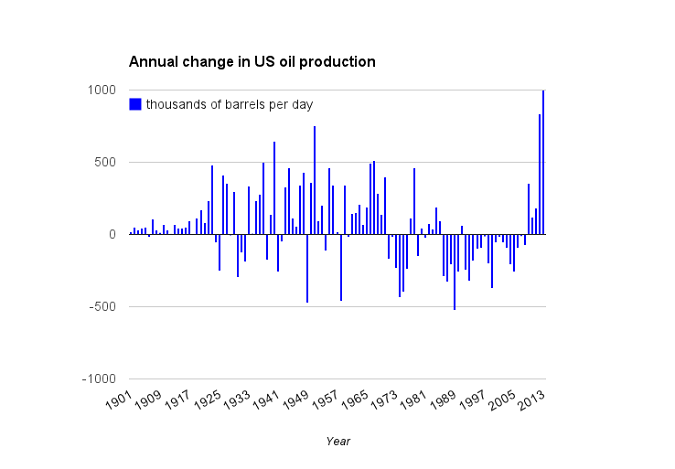2013 oil boom is biggest ever, data shows
The United States’ average daily oil production is on track to surge by 1 million barrels per day this year, the biggest one-year jump in the nation’s history, according to federal data.
The country has pumped an average of 7.5 million barrels of crude per day in 2013, up from 6.5 million barrels per day in 2012. That breaks last year’s record, when oil production jumped by 837,000 barrels per day between 2011 and 2012.
Feds: US oil boom’s end in sight
The U.S. Energy Information Administration projects that oil production will jump by another 1 million barrels per day in 2014, largely buoyed by drilling activity in Texas’ Eagle Ford Shale and Permian Basin regions, as well as North Dakota’s Bakken Shale.
The Gulf of Mexico also is seeing a boost, with oil production expected to grow to 1.4 million barrels per day in 2014, up by 100,000 barrels.

The data is evidence of the astonishingly rapid turnaround in the nation’s energy story. Oil production declined in 29 of the 40 years between 1971 and 2011. In total, oil production fell by about 40 percent during that time, from 9.5 million barrels per day in 1971 to 5.6 million barrels per day in 2011.
While the U.S. oil boom has sparked conversation of energy independence, Americans consume about 18 million barrels of liquid fuels per day, far more than is produced domestically.
Still, the production surge has caused oil imports to drop considerably. The nation shipped in an average of 7.9 million barrels per day of crude in September, the most recent period for which import data is available. That’s a significant drop from the peak in 2005, when the nation imported an average of 10.1 million barrels per day.
The country has pumped an average of 7.5 million barrels of crude per day in 2013, up from 6.5 million barrels per day in 2012. That breaks last year’s record, when oil production jumped by 837,000 barrels per day between 2011 and 2012.
Feds: US oil boom’s end in sight
The U.S. Energy Information Administration projects that oil production will jump by another 1 million barrels per day in 2014, largely buoyed by drilling activity in Texas’ Eagle Ford Shale and Permian Basin regions, as well as North Dakota’s Bakken Shale.
The Gulf of Mexico also is seeing a boost, with oil production expected to grow to 1.4 million barrels per day in 2014, up by 100,000 barrels.

The data is evidence of the astonishingly rapid turnaround in the nation’s energy story. Oil production declined in 29 of the 40 years between 1971 and 2011. In total, oil production fell by about 40 percent during that time, from 9.5 million barrels per day in 1971 to 5.6 million barrels per day in 2011.
While the U.S. oil boom has sparked conversation of energy independence, Americans consume about 18 million barrels of liquid fuels per day, far more than is produced domestically.
Still, the production surge has caused oil imports to drop considerably. The nation shipped in an average of 7.9 million barrels per day of crude in September, the most recent period for which import data is available. That’s a significant drop from the peak in 2005, when the nation imported an average of 10.1 million barrels per day.
You can return to the main Market News page, or press the Back button on your browser.

